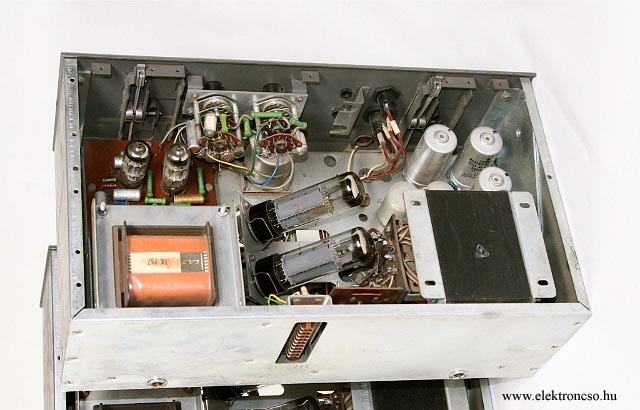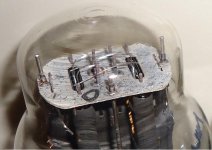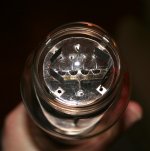Member
Joined 2009
Paid Member
According to RCA datasheet it's 'permissible' to mount it horizontally providing the filament is in a horizontal plane.
Anybody actually done this - any issues ?
I asked manufacturer of JJ-2A3-40 and they don't recommend it for a 2A3 or 300B from any manufacturer.
The reason for asking is that horizontal mounting provides another option, some flexibility in the physical construction of a project.
Anybody actually done this - any issues ?
I asked manufacturer of JJ-2A3-40 and they don't recommend it for a 2A3 or 300B from any manufacturer.
The reason for asking is that horizontal mounting provides another option, some flexibility in the physical construction of a project.
The Fi X 2A3 amplifier has them mounted sideways. I would suggest allowing for the sockets to be rotated a bit as I've not seen too many 2A3 tubes that always line up properly to the base pins as noted in the datasheet.
Personally, I still prefer them mounted vertically, but for NOS tubes, it was a supported practice.
Regards, KM
Personally, I still prefer them mounted vertically, but for NOS tubes, it was a supported practice.
Regards, KM
Member
Joined 2009
Paid Member
With indirectly heated cathods like the EL34 it doesn't much matter.45º angling?
Yes, you are absolutely correct.I always thought the filament was supposed to be vertical, not horizontal.
don't shoot the messenger
Well, according to the RCA data sheet published October 15, 1947, the accepted mounting position (for the 2A3) was changed to "Any". This would also account for the slack in the alignment spec for the base pins to filament. I've noticed the same on many 45 triodes.
Regards, KM
Well, according to the RCA data sheet published October 15, 1947, the accepted mounting position (for the 2A3) was changed to "Any". This would also account for the slack in the alignment spec for the base pins to filament. I've noticed the same on many 45 triodes.
Regards, KM
Member
Joined 2009
Paid Member
the RCA sheet I have was specific about orientation, but a Tung Sol data sheet said 'Any'. My conclusion is that it's safe for NOS, but there's no harm following the recommendation in the original RCA for orientation. If I remember it was to keep certain pins in a horizontal plane not the grid so it may be that it means the filament is vertical.
However, I'm interested in a modern 2A3. I can't see why these tubes would be less suitable for horizontal mounting - but I don't know and am still curious ? I notice that there are reviews on the internet for the JJ 2A3 in the Fi 2A3.
However, I'm interested in a modern 2A3. I can't see why these tubes would be less suitable for horizontal mounting - but I don't know and am still curious ? I notice that there are reviews on the internet for the JJ 2A3 in the Fi 2A3.
I suspect that the later data sheet referred to the tubes using sprung filaments. I have an older 6A3, and a couple of 6B4Gs with slightly larger cross section (rectangular) filaments that are not sprung. I suspect these might be more prone to sag in some positions.
Here is what mean by sprung and unsprung.
The one without the tension arms (unsprung) has a larger cross section filament.
Here is what mean by sprung and unsprung.
The one without the tension arms (unsprung) has a larger cross section filament.
Attachments
Last edited:
The Fi X 2A3 amplifier has them mounted sideways. I would suggest allowing for the sockets to be rotated a bit as I've not seen too many 2A3 tubes that always line up properly to the base pins as noted in the datasheet.
Personally, I still prefer them mounted vertically, but for NOS tubes, it was a supported practice.
Regards, KM
Been running my JJ's in my X for over a year now. No issues. There should be no issues with 'solid plates' but I wouldn't recommend 'mesh plates' mounted horizontally.
who cares if the filaments sag. it makes no difference sonically.
I would wager that the curves would change if the filament sagged closer to the grid therefore changing the "sound" of the tube. The geometry of the tube characterizes the function; distance of grid from plate, distance of grid from cathode (filament in a DHT), distance of cathode from plate ect.
These all effect the mu, gain, and properties of the tube, check out MJ's books for an overview. I would try to stick to vertical mounting whenever possible, other than that as has been previously stated, stick with the datasheets reccomendations as to vert. alignment of the grid and so on. My 2 cents.
- Status
- This old topic is closed. If you want to reopen this topic, contact a moderator using the "Report Post" button.
- Home
- Amplifiers
- Tubes / Valves
- 2A3 mounted horizontally

 how about 45degr angling instead
how about 45degr angling instead


